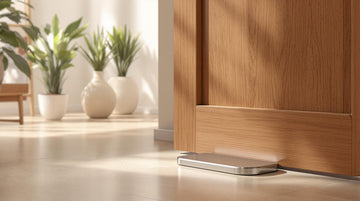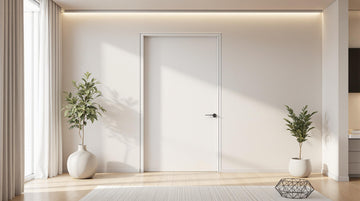
Stainless steel is the go-to material for door hardware because it resists corrosion, lasts for decades, and requires minimal upkeep. Its secret? A chromium oxide layer that forms on the surface, protecting it from rust - even in tough environments like coastal areas.
Key Takeaways:
- Why It Resists Corrosion: Chromium (10.5% or more) creates a self-healing oxide layer that blocks rust.
-
Best Grades for Use:
- 304 Stainless Steel: Great for indoor use, standard corrosion resistance.
- 316 Stainless Steel: Ideal for coastal/outdoor areas; 40% better salt resistance due to added molybdenum.
- 410 Stainless Steel: Strong and magnetic, perfect for internal mechanisms.
- Maintenance Tips: Regular cleaning, avoiding abrasive tools, and applying lubricant extend hardware life.
Quick Comparison of Grades:
| Grade | Best Use Case | Corrosion Resistance | Cost Factor | Lifespan in Coastal Areas |
|---|---|---|---|---|
| 304 | Indoor environments | Standard | Base price | Less than 15 years |
| 316 | Coastal/outdoor areas | 40% higher than 304 | 20% higher | 25+ years |
| 410 | Internal mechanisms | Low | Moderate | Maintenance required |
Stainless steel hardware is durable, eco-friendly, and cost-effective over time. For long-lasting results, match the grade to your environment and follow simple care steps.
Stainless Steel's Anti-Corrosion Mechanisms
Chromium's Protective Barrier
Chromium plays a key role in stainless steel's resistance to corrosion by forming a passive protective layer. This barrier, along with its ability to repair itself, makes stainless steel a great choice for door hardware.
Impact of Metal Composition
Chromium is crucial, but grades like 316 stainless steel go a step further by including molybdenum. This addition boosts resistance to corrosion in salty environments [2][4]. That’s why 316-grade stainless steel is often used in coastal areas where salt-laden air can damage door hardware.
Tests back this up: 316 stainless steel can endure over 1,000 hours of salt spray exposure without showing red rust. In contrast, standard carbon steel starts corroding in under 100 hours [2]. For hardware installed within a mile of the ocean, companies like Atlantic Stainless Steel recommend 316-grade materials to handle the challenges of salt spray and high humidity [1][4].
Choosing Stainless Steel Grades for Doors
304 and 316 Steel Comparison
Picking between 304 and 316 stainless steel plays a big role in determining how long your door hardware will last. 304 stainless steel works well for most indoor environments, offering solid corrosion resistance. On the other hand, 316 stainless steel includes 2-3% molybdenum, making it about 40% better at resisting salt corrosion compared to 304 [2][4].
| Feature | 304 Grade | 316 Grade |
|---|---|---|
| Best Use Case | Indoor environments | Coastal areas, pool facilities |
| Corrosion Resistance | Standard | 40% higher than 304 |
| Cost Factor | Base price | 20% higher than 304 [4] |
| Lifespan in Coastal Areas | Less than 15 years | 25+ years [5] |
High-Strength Steel Options
For magnetic door hardware, martensitic 410 stainless steel stands out with its impressive strength, boasting yield ratings between 600-900 MPa [2][4]. This grade is perfect for internal mechanisms where strength and magnetism are more critical than corrosion resistance.
A great example of this combination can be seen in commercial products like StealthStop.
StealthStop Door Stopper Features

StealthStop demonstrates how to blend these material properties effectively. Its design uses a 316 stainless steel housing paired with martensitic steel cores, achieving a balance between corrosion resistance and magnetic performance [3]. The 316 housing handles humid environments with ease, while the internal components deliver reliable magnetic strength.
For coastal installations (within one mile of the shore), these units endure 1,000+ salt spray hours without rusting [2]. With proper care, they provide dependable performance even in tough coastal conditions.
Maintaining Stainless Steel Door Hardware
Surface Protection Methods
Keeping stainless steel door hardware in good condition requires attention to its surface protection. One effective option is powder coating, which not only enhances the look with finishes like Matt Black or Urban Bronze but also shields the metal from exposure to corrosive elements [1]. These coatings act as a barrier, protecting the surface from damage caused by salt, moisture, or pollutants.
The hardware's design also matters. Many modern options feature seamless designs, which reduce weak spots where moisture or debris could accumulate. When paired with 316-grade stainless steel, these features make the hardware more durable, especially in tough environments.
| Protection Method | Benefits | Ideal Use |
|---|---|---|
| Powder Coating | Blocks salt air, retains appearance | Coastal areas |
| Seamless Design | Prevents moisture buildup | High-humidity zones |
Cleaning and Care Steps
Even though stainless steel can repair minor damage on its own, regular care is key to keeping it in top shape. In coastal regions, monthly inspections during humid months allow you to address potential corrosion early [2]. In less demanding environments, checking the hardware every three months is usually enough [1].
For everyday maintenance:
- Daily: Wipe with a dry cloth.
- Weekly: Clean with soap and water.
- Monthly: Apply silicone lubricant to moving parts [1].
If you spot early signs of corrosion, use a solution of 1 part vinegar to 3 parts water for cleaning [1].
What to Avoid:
- Abrasive cleaners or steel wool, which can scratch or strip coatings [1].
- Skipping regular lubrication of mechanisms.
- Letting salt spray or harsh weather sit on the hardware without cleaning it promptly [1].
sbb-itb-7d66a95
Related video from YouTube
Conclusion: Long-Term Value of Stainless Steel
Stainless steel door hardware, when paired with proper maintenance, offers decades of durability - especially in coastal regions where other metals corrode 3-5 times faster [1]. Its chromium layer naturally repairs itself, cutting down on frequent replacement expenses [4].
From a cost perspective, the long-term savings become evident when factoring in lifecycle costs, which ties back to the grade selection principles discussed earlier. Beyond cost, stainless steel aligns with environmentally conscious architecture. Its durability and ability to be recycled indefinitely without losing quality make it an eco-friendly option. Advances in high-performance door hardware continue to enhance its protective features.
"When considering product longevity, Boston Consulting Group's analysis shows that stainless steel actually achieves net negative emissions due to its exceptional durability and complete recyclability" [4].
With the right grade and upkeep, stainless steel offers unparalleled longevity, all while minimizing environmental impact. It maintains both its function and appearance over decades, making it a smart choice for residential and commercial projects alike.
FAQs
Which stainless steel is best for doors?
The choice of stainless steel depends on where and how it's used. For indoor doors, 304 stainless steel is a reliable option, offering a balance between cost and corrosion resistance. If you're dealing with coastal environments or outdoor hardware, 316 stainless steel is better suited thanks to its added molybdenum, which helps protect against salt damage.
| Grade | Ideal Use | Features |
|---|---|---|
| 304 SS | Indoor hardware, controlled spaces | - Affordable - Standard corrosion resistance |
| 316 SS | Outdoor/coastal areas | - Added salt protection - Long-lasting performance |
| 410 SS | High-security parts | - Heat-treatable - Requires regular upkeep |
For guidance on keeping your stainless steel in top condition, check out the 'Cleaning and Care Steps' section above.





